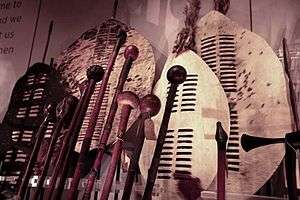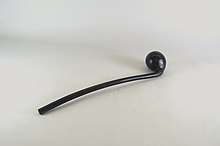Knobkerrie
A knobkerrie, also spelled knobkerry, knobkierie, and knopkierie (Afrikaans), is a form of club used mainly in Southern and Eastern Africa. Typically they have a large knob at one end and can be used for throwing at animals in hunting or for clubbing an enemy's head.[1]

Name
The name derives from the Afrikaans word knop, meaning knob or ball and the Khoekhoe or San word kirri, meaning walking stick.[2] The name has been extended to similar weapons used by the native peoples of Australia, the Pacific islands and other places, and was also used in the British army.
Uses in southern Africa and abroad

Knobkerries were an indispensable weapon of war both in Africa and abroad. In Africa, the weapon found particular use among Nguni peoples. Among the Zulu people they are known as iwisa. The iwisa was not typically used in combat – though they were occasionally used as thrown weapons in place of the throwing spear or isijula. Instead, the Zulu used iwisa as swagger sticks, ceremonial objects, or even as snuff containers. In the 20th century, the Zulu nationalist movement Inkatha viewed iwisa as traditional weapons and lobbied for the right to carry such weapons in public.[3][4]
The Ndebele variant was known as induku and similar in design to the Zulu iwisa. It was used as a swagger stick or thrown weapon. The induku could also be fashioned into the handle of a fighting axe which, unlike the Zulu, the Ndebele used as weapons of war. Tsonga clubs were also similar to the Zulu and Ndebele type with spherical heads but variants with more elongated oval heads were also used in what is now Mozambique. The Sotho under Mosheshe did not adopt Zulu style weapons and tactics and so unlike the Zulus it was regarded as an important weapon of war.[3]
Outside Africa, the British called their trench clubs knobkerries during World War I, though their form was often not traditional.[5][6][7] The weapon was used in No Man's Land by the poet Siegfried Sassoon as relayed in the Sherston trilogy, his pseudonymous autobiography.[8]
During the Apartheid era in South Africa, they were often carried and used by protesters and sometimes by the police opposing them.[9][10] Knobkerries are still widely carried, especially in rural areas, while in times of peace it serves as a walking-stick, sometimes ornamental. Knobkerries are still commonly carried by protesters.[11][12]
Knobkerries commonly feature on national and other symbols in Southern Africa. In South Africa they feature on the South African Coat of Arms,[13] though lying down symbolising peace. They are also depicted on the Order of Mendi for Bravery.[14] A knobkerrie appeared on the former flag of Lesotho between 1987 and 2006, on the Coat of Arms and royal standards of Lesotho since its independence in 1966, and on the Coat of Arms of the former (nominally independent) republic of Ciskei.
Uses for Sotho people
Known as molamu or thoka, it is a stick and can be a walking stick or alternatively, it can be used as a weapon.[15] The molamu is a stick that is made from the Mohlware tree Olea africana.[16] It is a fighting stick carried by men and boys from puberty.
Practical use
A molamu symbolises authority and power, and represents a readiness to separate an enemy from a friend. The molamu is to symbolically used to break, to protect, to judge and to rectify social injustices.
Initiation
The molamu is an indicator of one's adult male status along with the Basotho blanket seana marena, and are visual expressions of both practical and esoteric Sesotho ideals.[15] Molamu is a sign of manhood, all male initiates carry it upon their return from lebollo la banna. The molamu is traditionally passed down from one generation to another as men go through initiation. It is used to declare to Badimo that the young man has returned from his initiation, and garners their support and blessings.[17] The molamu is held up while the initiates sing “ditoko”, with the singer's eyes intently focused upon it. The molamu is also used to teach initiates the methods of “ho ya ka lanwa”, which is a historical Sesotho martial art.[15]
Spiritual use
The molamu is also used to bind empowering medicines, or moriana, to the staff, which affects the “seriti” which is the character or spirit of the owner. It is also a visual indicator of one's transition to adulthood, and maintains spiritual significance in Sesotho society.[15]
Modern uses
Following an initiate's public introduction as a functioning member of Sesotho adult society the molamu is typically stored in the ceiling of one's home, and represents the physical presence of the unseen.
In contemporary southern Africa, one can also find decorative variations carried by new initiates after returning to their homes. These serve as accessories to the heavily ornamented outfits worn by the young men as a sign of celebration during the weeks following their return, and equally express the celebration of newly gained adulthood, drawing attention to the initiates.[18]
See also
- Rungu (weapon) a similar club common in East Africa
- Shillelagh similar club associated with Ireland
- Wilbur Smith, the South African author, in his book When the Lion Feeds, also refers to these weapons as kerrie which are used to throw at birds and animals in the bush to kill them
- Sotho people
References
- Rudolph, C. J. A guide for the Zulu court interpreter. Pietermaritzberg: Shuter & Shooter.
- "knobkerrie | Definition of knobkerrie in English by Oxford Dictionaries". Oxford Dictionaries | English. Retrieved 2019-04-11.
- Spring, Christopher (1993). African arms and armour. British Museum Press. ISBN 0714125083. OCLC 611561101.
- sahoboss (2011-03-16). "Buthelezi says Zulus would continue carrying cultural weapons". South African History Online. Retrieved 2019-04-11.
- Canada in the Great World War: an authentic account of the military history of Canada from the earliest days to the close of the war of the nations. Toronto: United Publishers of Canada. 1918.
- Dawson, Alec John (1918). A "Temporary gentleman" in France; home letters from an officer at the front. London, New York: Putnam. p. 94.
- "Trench Club and Knobkerrie and Royal Engineers Type". Imperial War Museum. IWM. Retrieved 12 January 2019.
- Sassoon, Siegfried (1930). Memoirs of an Infantry Officer. Faber & Faber. ISBN 978-0571268443.
- "Amnesty Hearing - Vlisi Thokozani Manqele". Department of Justice and Constitutional Development. 1999-02-01. Retrieved 2008-11-27.
- "Amnesty Hearing - Victor Mthandeni Mthembu". Department of Justice and Constitutional Development. 1998-07-06. Retrieved 2008-11-27.
- "Protesters attack mayor with knobkierie | IOL News". www.iol.co.za. Retrieved 2019-04-11.
- "'We don't have water, we don't have houses, we have nothing' – Vredenburg protester". News24. 2018-11-14. Retrieved 2019-04-11.
- "National Coat of Arms". South African Government Information. Retrieved 2008-11-27.
- "National Orders". The Presidency of the Republic of South Africa. Archived from the original on September 15, 2008. Retrieved 2008-11-27.
- "Visual Symbols of Self: South Sotho Arts and Initiation". University of Iowa. Retrieved 11 March 2019.
- Nakin, Moroesi R; Kock, Inie J (2016). "Insights into translation and the original text: Thomas Mofolo's Chaka". Tydskrif vir Letterkunde. 53 (2): 117–127. doi:10.17159/tvl.v.53i2.9.
- Riep, David Matthew Merkel. "House of the Crocodile: south Sotho art and history in southern Africa." PhD (Doctor of Philosophy) thesis, University of Iowa, 2011.http://ir.uiowa.edu/etd/2616. Futhwa, Fezekile. "Setho: Afrikan Thought and Belief System. Nalane ka Fezekile Futhwa, May 2011
- Riep, David Matthew Merkel. "House of the Crocodile: south Sotho art and history in southern Africa." PhD (Doctor of Philosophy) thesis, University of Iowa, 2011.http://ir.uiowa.edu/etd/2616. Futhwa, Fezekile. "Setho: Afrikan Thought and Belief System. Nalane ka Fezekile Futhwa, May 2011
Further reading
- Dougherty, Terri (2008). Zulu Warriors. New York: Capstone Press.
- Journal of Natal and Zulu History (1992). University of Natal. Dept. of History. Durban: South Africa.
- Knight, Ian (1989). The Zulus. London: Osprey Press.
External links
